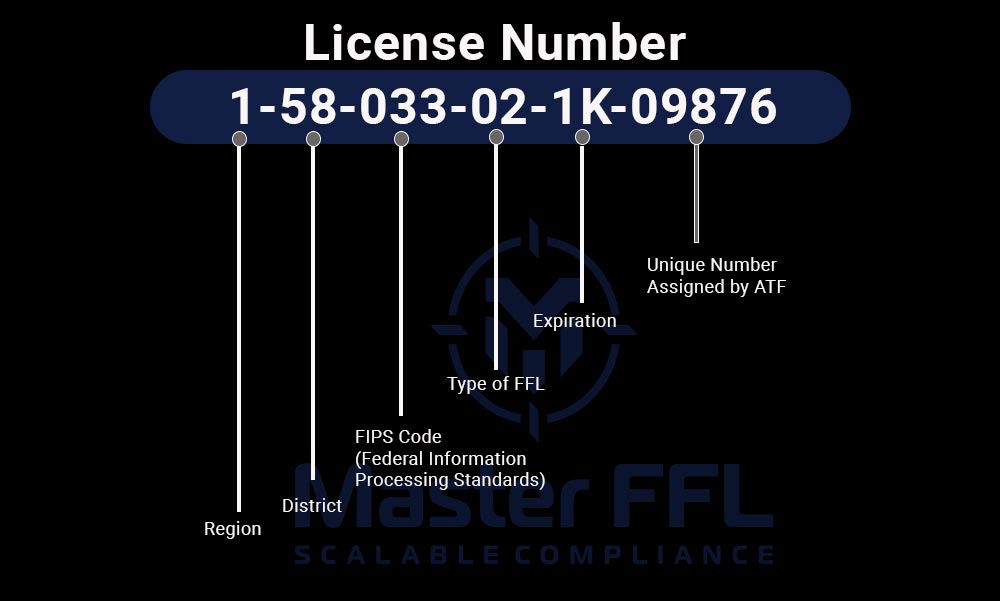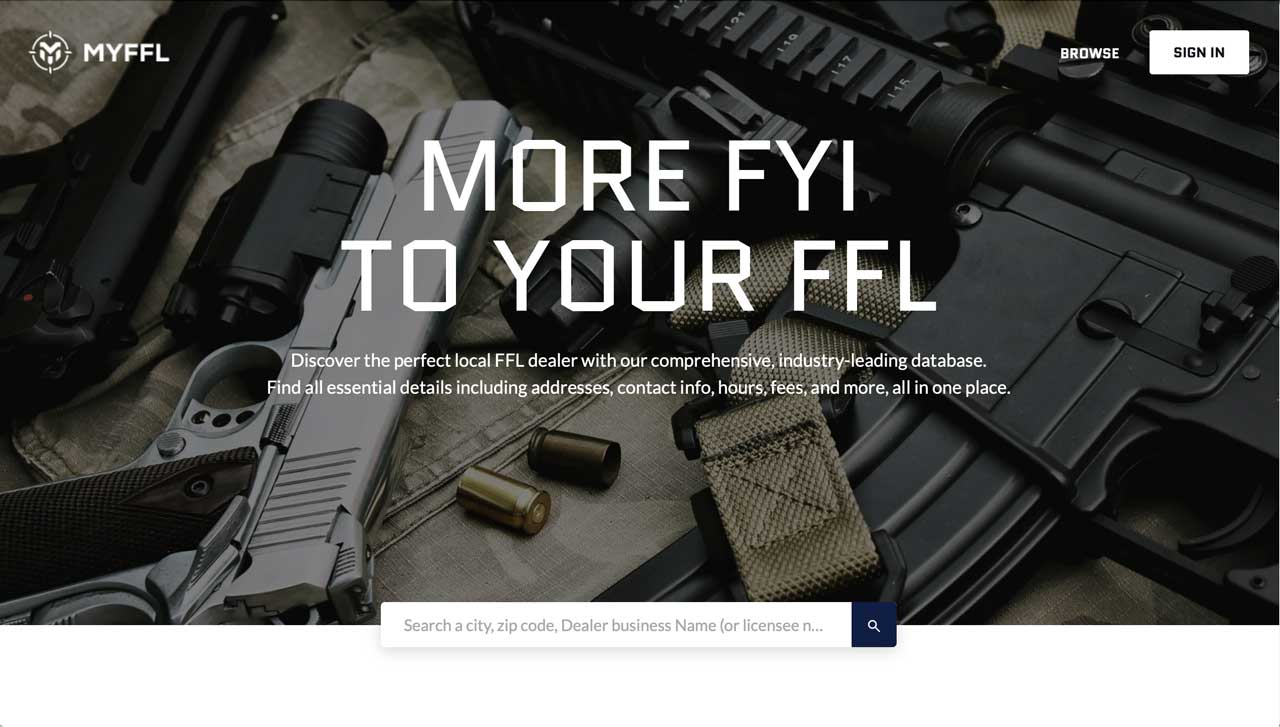
Understanding the FFL License Number Format
Every Federal Firearms License (FFL) is given a unique FFL number by the ATF. This number serves not only to identify the specific FFL holder but also contains additional important details. By understanding how to decode an FFL number, you can determine the license type, the issuing location, and even the expiration date of the license.
An FFL (Federal Firearms License) number is more than just a series of digits. It contains critical information about the license holder, including their location and the type of activities they’re authorized to conduct. This article breaks down the structure of an FFL number, helping you decode the meaning behind each digit.
What Does an FFL Number Mean?
An FFL (Federal Firearms License) number consists of 14 digits and one letter, structured into six distinct sections that provide key details about the license. An example of an FFL number might look like this: 1-58-033-02-1K-09876. Each section contains specific information, but the fourth and fifth sections are particularly crucial.
These sections can help you detect potential issues with the FFL, such as incorrect locations or inaccurate expiration dates. By understanding these parts, you can identify fraud or errors early on, preventing future compliance problems.

The First Section of an FFL Number
The ATF (Bureau of Alcohol, Tobacco, Firearms, and Explosives) divides the United States into seven regions to streamline administrative processes and license issuance. This regional structure ensures more efficient handling of tasks, as opposed to centralizing all operations in one location without local or regional offices.
The first section of an FFL number is a single digit that represents the region where the license was issued. Interestingly, the ATF skipped numbers 2 and 7 when designating these regions, so only certain numbers are used to indicate them.
1 – Southeast
3 – Midwest
4 – Central
5 – Southwest
6 – North Atlantic
8 – Mid Atlantic
9 – Western

The Second Section of an FFL Number
The second section of an FFL number is composed of two digits, which might seem like a historical quirk. This part of the number dates back to when the ATF was under the umbrella of the U.S. Treasury Department, during the days of Prohibition enforcement (think Elliot Ness and the Untouchables). These two digits indicate the original IRS district where the FFL was registered. Although this information is no longer relevant to the current operations of the ATF, the old numbering system remains in place for FFL numbers today.
To decode this section, you have access to a full list of these district codes and what they represent. Alternatively, you can verify most licenses directly with the ATF for additional details.
- 01: Maine, New Hampshire, Vermont
- 02: Massachusetts
- 03: Rhode Island, Connecticut
- 04: New York (excluding New York City)
- 05: New York City
- 06: New Jersey
- 07: Pennsylvania
- 08: Delaware
- 09: Maryland
- 10: Washington, D.C.
- 11: Virginia
- 12: West Virginia
- 13: North Carolina
- 14: South Carolina
- 15: Georgia
- 16: Florida
- 21: Alabama
- 22: Mississippi
- 23: Louisiana
- 24: Arkansas
- 25: Tennessee
- 26: Kentucky
- 31: Ohio
- 32: Indiana
- 33: Michigan
- 34: Illinois
- 35: Wisconsin
- 36: Minnesota
- 41: Iowa
- 42: Missouri
- 43: North Dakota
- 44: South Dakota
- 45: Nebraska
- 46: Kansas
- 51: Montana
- 52: Idaho
- 53: Wyoming
- 54: Colorado
- 55: New Mexico
- 56: Arizona
- 61: Utah
- 62: Nevada
- 63: Oregon
- 64: Washington
- 65: Alaska
- 71: Hawaii
- 72: Puerto Rico
- 73: U.S. Virgin Islands
- 74: Guam
- 75: Northern Mariana Islands
- 76: American Samoa
These codes were initially used to indicate the IRS district, and while they are now mostly for historical reference, they remain part of the structure of an FFL number today.

The Third Section of an FFL Number
The third section of an FFL number relates to the Federal Information Processing Standards (FIPS) code, which identifies the specific area where the FFL holder is located. However, this part of the number is generally not useful for most purposes. The FIPS codes often change and can occasionally be duplicated, making them unreliable for verifying the legitimacy of an FFL. Essentially, this section exists primarily for federal administrative purposes and does not provide significant value to those looking to confirm the details of an FFL license.
FFL District Codes by State:

The Fourth Section of an FFL Number
The fourth section of an FFL number is crucial as it indicates the type of FFL license held by the individual or business. Different types of FFLs authorize different types of activities. For example, a license designated as an “03 Curio and Relic FFL” would not permit the holder to transfer modern firearms.
Understanding the type of FFL you are dealing with is essential because it tells you exactly what the license holder is legally allowed to sell or manufacture. Some FFLs are limited to selling common firearms, while others are authorized to produce and distribute a full range of firearms, including those regulated by the National Firearms Act (NFA).
To ensure you are engaging with a properly licensed entity, always check the fourth section of their FFL number to confirm the type of license they hold.
Types of FFLs and Their Corresponding Numbers
Here is a list of the different types of Federal Firearms Licenses (FFLs) and their associated numbers:
- Type 01: Dealer in Firearms Other Than Destructive Devices
- This license allows the holder to engage in the business of dealing in firearms, excluding destructive devices.
- Type 02: Pawnbroker in Firearms Other Than Destructive Devices
- This license permits a pawnbroker to deal in firearms, but not destructive devices.
- Type 03: Collector of Curios and Relics
- This is a license for collectors of curios and relics only. It does not allow the licensee to deal in or manufacture modern firearms.
- Type 06: Manufacturer of Ammunition for Firearms
- This license authorizes the holder to manufacture ammunition, but it does not cover the manufacture of armor-piercing ammunition.
- Type 07: Manufacturer of Firearms Other Than Destructive Devices
- This license allows the holder to manufacture and deal in firearms and ammunition, excluding destructive devices. It also covers the ability to sell NFA items, like suppressors.
- Type 08: Importer of Firearms Other Than Destructive Devices
- This license permits the holder to import firearms and ammunition, excluding destructive devices and armor-piercing ammunition.
- Type 09: Dealer in Destructive Devices
- This license allows the holder to deal in destructive devices, such as grenades, bombs, and certain large caliber weapons.
- Type 10: Manufacturer of Destructive Devices, Ammunition for Destructive Devices, or Armor Piercing Ammunition
- This license is for manufacturing destructive devices, their ammunition, and armor-piercing ammunition.
- Type 11: Importer of Destructive Devices, Ammunition for Destructive Devices, or Armor-Piercing Ammunition
- This license allows the importation of destructive devices, their ammunition, and armor-piercing ammunition.
- Type 14: Manufacturer of Firearms Other Than Destructive Devices with a Limited Scope
- This type is specific to certain manufacturers and has a limited scope that restricts activities beyond the basic manufacturing of firearms.
Understanding these different types of FFLs is important for ensuring compliance with federal regulations and conducting transactions within the scope of what each license permits.

The Fifth Section of an FFL Number
The fifth section of an FFL number reveals the expiration month and year of the license. This part consists of a number and letter combination, such as “1A.” The number represents the year the license will expire. For example, “1” indicates that the FFL expires in 2021. Since FFLs are only issued for three-year periods, there is no need to worry about determining the decade.
The letter in the combination specifies the month of expiration. In our example, “A” corresponds to January, so “1A” means the FFL expires in January of 2021. It’s important to note that the ATF does not use the letter “I” in these codes to avoid confusion with the number “1.”
Full List of Letter Codes for Expiration Months:
- A – January
- B – February
- C – March
- D – April
- E – May
- F – June
- G – July
- H – August
- J – September
- K – October
- L – November
- M – December
By understanding the fifth section, you can quickly determine when an FFL will expire and ensure that the license is still valid.

The Sixth Section of an FFL Number
The sixth section of an FFL number is a five-digit sequence that serves as the unique identifier for each Federal Firearms License holder. This number, combined with the district code from the second section, makes each FFL distinct. While the other parts of the FFL number provide administrative details—such as the issuing location, expiration date, and license type—the sixth section specifically identifies the individual or entity holding the license.
When verifying an FFL, you primarily need to focus on the first three digits (which indicate the issuing location) and the final five digits (which identify the specific FFL holder). The middle sections mainly provide quick reference details about the license type and expiration date or are used for internal purposes by the ATF.
How to Use This Information
By understanding the structure of the FFL number, you can easily identify the license type, the geographical location of the licensee, the ATF district they belong to, their unique identifier, and the expiration date of their license. This information is particularly useful for verifying the legitimacy of a firearms dealer or manufacturer and ensuring compliance with federal regulations.
Decoding an FFL license number is straightforward once you know what each section represents. This knowledge helps maintain transparency and trust in firearm transactions, making it easier for both buyers and sellers to ensure they’re working within the bounds of the law.
Get Started with MasterFFL Today!
Streamline your firearm transactions and ensure compliance with our powerful solutions. Sign up now and see how MasterFFL can optimize your business operations!
Find a Trusted FFL Dealer Near You!
Use MyFFL.com to easily locate verified FFL dealers in your area and ensure smooth, secure transactions. Start your search now!






